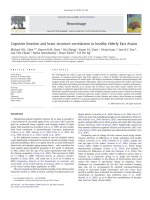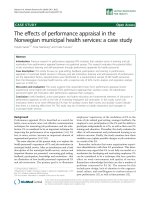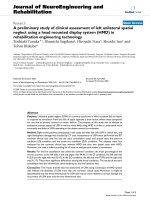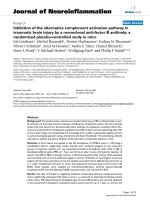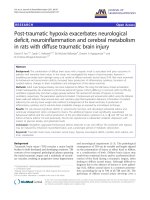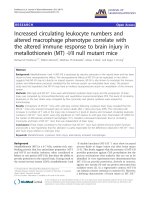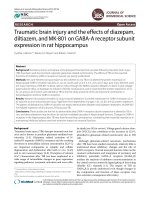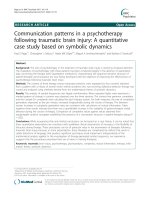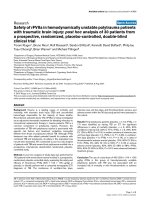cognitive function and traumatic brain injury in refugees and asylum-seekers attending mental health services a preliminary study ; and clinical research portfolio
Bạn đang xem bản rút gọn của tài liệu. Xem và tải ngay bản đầy đủ của tài liệu tại đây (1.36 MB, 125 trang )
Glasgow Theses Service
Christie, Zara (2014) Cognitive function and traumatic brain injury in refugees and asylum-
seekers attending mental health services: a preliminary study ; and Clinical Research
Portfolio. D Clin Psy thesis.
Copyright and moral rights for this thesis are retained by the author
A copy can be downloaded for personal non-commercial research or
study, without prior permission or charge
This thesis cannot be reproduced or quoted extensively from without first
obtaining permission in writing from the Author
The content must not be changed in any way or sold commercially in any
format or medium without the formal permission of the Author
When referring to this work, full bibliographic details including the
author, title, awarding institution and date of the thesis must be given
Cognitive function and traumatic brain injury in refugees and asylum-
seekers attending mental health services – a preliminary study
And Clinical Research Portfolio
Volume 1
(Volume 2 bound separately)
Zara Christie, BSc Honours
Submitted in partial fulfilment of the requirements for the degree of
Doctorate in Clinical Psychology
Institute of Health and Wellbeing
College of Medical, Veterinary and Life Sciences
University of Glasgow
October 2014
1
ACKNOWLEDGEMENTS
Firstly I would like to thank my supervisors Professor Tom McMillan and Dr Sharon
Doherty for their ongoing guidance, support and enthusiasm throughout this project. I
would like to thank Sarah McCullough from NHS Health Scotland for her interest in this
research and for her role in obtaining funding which made this research possible. Further
thanks go to Nicola Greenlaw from the Robertson Centre at the University of Glasgow for
her statistical support. I would also like to thank all my participants, as well as Compass
staff and interpreters; the success of this research would not have been possible without
your support.
I would like to thank my friends, both on and off the course for their support and
understanding over the last three years. I would also like to say a huge thank you to my
fiancé Francisco for his patience and statistical knowledge, my sister Ayesha for her
support and proof-reading and mum Nasim for her ongoing encouragement throughout the
Doctorate. Finally, I would like to thank my dad, Alastair, for always believing in me and
encouraging me to apply to the Doctorate in Glasgow!
2
Dedicated in loving memory to my father, Alastair.
Your star shines on.
3
TABLE OF CONTENTS
Declaration of Originality Form 5
CHAPTER 1: SYSTEMATIC REVIEW 6
Validity of the translated and modified Mini-Mental State Examination within
South, East, and South East Asian countries
Summary 7
Introduction 8
Methods 11
Results 15
Discussion 27
Conclusion 30
References 31
CHAPTER 2: MAJOR RESEARCH PROJECT 37
Cognitive function and traumatic brain injury in refugees and asylum-seekers
attending mental health services – a preliminary study
Plain English Summary 38
Abstract 39
Introduction 40
Methods 45
Results 51
Discussion 57
Conclusion 62
Acknowledgements 63
References 64
CHAPTER 3: ADVANCED CLINICAL PRACTICE I - REFLECTIVE ACCOUNT 72
Reflections on communicating with clients in dyadic, triadic and group
therapeutic encounters
Abstract 73
CHAPTER 4: ADVANCED CLINICAL PRACTICE II - REFLECTIVE ACCOUNT 74
Research and evaluation within the NHS: reflections on conducting research as
a trainee and upon qualification
Abstract 75
4
APPENDICES
SYSTEMATIC REVIEW
Appendix 1.1. Critique of Steis and Schrauf’s (2009) paper 76
Appendix 1.2. Search Strategy 77
Appendix 1.3. Quality Rating Scale 78
Appendix 1.4. Table of inter-rater reliability 79
Appendix 1.5. Methodological Quality Rating 80
Appendix 1.6. Adaptations to the MMSE 82
Appendix 1.7 Authors guidelines for the International Journal of Geriatric Psychiatry… 84
MAJOR RESEARCH PROJECT
Appendix 2.1. Ethics Committee Provisional Favourable Opinion 89
Appendix 2.2. Confirmation of Ethical Approval 94
Appendix 2.3. NHS R&D Board Approval 97
Appendix 2.4. Ethical Approval following minor amendment 99
Appendix 2.5. NHS R&D Board Approval following minor amendment 101
Appendix 2.6. Head Injury Screening Form 102
Appendix 2.7. Participant Information sheet 104
Appendix 2.8. Consent Form 106
Appendix 2.9. Table of causes of TBIs 107
Appendix 2.10. Author Guidelines for the Journal of the International Neuropsychological
Society. 108
Appendix 2.11. Major Research Project Proposal 112
LIST OF TABLES AND FIGURES
SYSTEMATIC REVIEW
Figure 1. Flowchart of the selection process 15
Table 1. Demographics table 17
MAJOR RESEARCH PROJECT
Figure 1. Recruitment flowchart of the selection process 46
Table 1. Participant demographics and descriptive analysis 52
Table 2. TBI characteristics 53
Table 3. Clinical vignettes 54
Table 4. Comparing TBI and non-TBI groups on CTT and additional tests 55
Table 5. Comparing sample and normative data on CTT and additional tests 56
Table 6. Normative data for comparison with the study sample 57
5
Declaration of Originality Form
This form must be completed and signed and submitted with all assignments.
Please complete the information below (using BLOCK CAPITALS).
Name: ZARA CHRISTIE
Student Number: 1104518c
Course Name: DOCTORATE IN CLINICAL PSYCHOLOGY
Assignment Number/Name: CLINICAL RESEARCH PORTFOLIO
An extract from the University’s Statement on Plagiarism is provided overleaf. Please read
carefully THEN read and sign the declaration below.
I confirm that this assignment is my own work and that I have:
Read and understood the guidance on plagiarism in the Doctorate in Clinical Psychology
Programme Handbook, including the University of Glasgow Statement on Plagiarism
Clearly referenced, in both the text and the bibliography or references, all sources used in
the work
Fully referenced (including page numbers) and used inverted commas for all text quoted
from books, journals, web etc. (Please check the section on referencing in the ‘Guide to
Writing Essays & Reports’ appendix of the Graduate School Research Training Programme
handbook.)
Provided the sources for all tables, figures, data etc. that are not my own work
Not made use of the work of any other student(s) past or present without
acknowledgement. This includes any of my own work, that has been previously, or
concurrently, submitted for assessment, either at this or any other educational
institution, including school (see overleaf at 31.2)
Not sought or used the services of any professional agencies to produce this work
In addition, I understand that any false claim in respect of this work will result in
disciplinary action in accordance with University regulations
DECLARATION:
I am aware of and understand the University’s policy on plagiarism and I certify that this
assignment is my own work, except where indicated by referencing, and that I have followed
the good academic practices noted above
Signature Date
6
CHAPTER 1: SYSTEMATIC REVIEW
Validity of the translated and modified Mini-Mental State Examination
within South, East, and South East Asian countries
Zara Christie
1
1
Address for Correspondence:
Mental Health and Wellbeing
University of Glasgow
1
st
Floor, Administrative Building
Gartnavel Royal Hospital
1055 Great Western Road
Glasgow, G12 0XH
Submitted in partial fulfilment of the requirements for the degree of Doctorate in Clinical
Psychology. Written in accordance with the manuscript preparation guidelines for the
International Journal of Geriatric Psychiatry (Appendix 1.7).
7
SUMMARY
Objective: Approximately 16 million people with dementia live in low-economy countries;
however, most cognitive screens have been developed in Western societies. This review
considers studies that have validated the Mini-Mental State Examination (MMSE), the
most commonly used cognitive screen, in native languages spoken in Asia, and explores its
validity for illiterate or poorly-educated individuals.
Methods: Studies included in the review were identified by searching electronic databases
(Ovid MEDLINE, EMBASE, PsycINFO and Web of Science), reviewing the reference
lists of included articles and hand-searching a key journal. Included were studies that
attempted to validate the MMSE in South, East and South East Asia. Eligible studies were
rated for methodological quality using a rating scale devised for this review.
Results: Nine studies were eligible for inclusion; their quality was rated as high for 3,
moderate for 4, and low for 2 studies. The MMSE was translated and validated in 5
languages across 6 countries. Cut-offs for impairment ranged from 17-24, which yielded
wide-ranging sensitivity (83.87-100%) and specificity (60.6-100%).
Conclusion: Translations of the MMSE are valid and reliable to screen for cognitive
impairment; however, these results cannot be generalised due to limited reporting on the
severity of dementia. There were mixed results regarding the validity of the MMSE to
detect cognitive impairment in illiterate or poorly-educated people.
Keywords: Systematic review, MMSE, translation, validity, South East Asia
8
INTRODUCTION
Cognitive impairment ranges in severity, can occur at any point in a person’s lifetime, and
can result in difficulties remembering, learning new concepts, concentrating, or making
decisions about everyday life. Mild cognitive impairment (MCI) is defined as the objective
and subjective decline in cognition and function, which is greater than expected for an
individual’s age and level of education. An individual with MCI does not meet the criteria
for a diagnosis of dementia (Peterson, 2004). There are multiple causes of cognitive
impairment, including acquired and traumatic brain injuries (TBI), strokes, diabetes,
hypertension, and the ageing process itself (Manly et al., 2005). Every year, approximately
10 million people are affected by a TBI. The World Health Organisation states that by
2020, TBIs will become the biggest cause of death and disabilities worldwide (Hyder et
al., 2007). Severe cognitive impairment results in more profound difficulties, which
include a diagnosis of dementia.
It is recommended that for all patients presenting with cognitive complaints, a brief
cognitive screen is administered to assess the presence and severity of any memory or
cognitive deficits (Jacova et al., 2007). There are a number of screening measures which
aim to highlight genuine cognitive impairment. Cullen et al. (2007) highlight that the
following six core domains should be covered in a screening tool: attention/working
memory, new verbal learning/recall, expressive language, visual construction, executive
function, and abstract reasoning. High sensitivity (the proportion of people with cognitive
impairment with a positive result), and high specificity (the proportion of people without
cognitive impairment with a negative result; Cullen et al., 2007) are important to establish
the validity of a screening measure (O’Bryant et al., 2008). However, the diagnostic utility
of a particular person’s score is represented by the screen’s predictive values. Positive
9
predictive values (PPV) represent the probability that a person who has scored below the
cut-off in a hypothetical population is actually cognitively impaired, while negative
predictive values (NPV) represent the probability that a person who has scored above the
cut-off is not cognitively impaired (O’Bryant et al., 2008).
Clinical surveys indicate that there is no single cognitive screen adequate for all purposes;
however, the Mini-Mental State Examination (MMSE; Folstein, Folstein, & McHugh,
1975) is most commonly used in practice (Shulman et al., 2006). Benefits of the MMSE,
and other measures such as the Addenbrooke’s Cognitive Examination-Revised (ACE-R;
Moishi et al., 2006) and the Montreal Cognitive Assessment (MoCA; Nasreddine et al.,
2005) include their brevity (8–16 minutes to administer) and minimal training
requirements for the administrator.
There are many screening measures for cognitive impairment. However, most of these
have been developed in Western societies (Chui & Lam, 2007), and few are validated in
the populations in which they are subsequently used (Cullen et al., 2007). Steis and
Schrauf (2009) reviewed twenty translations and adaptations of the MMSE worldwide,
highlighting the breadth of its use and the importance of education and literacy. However,
their review did not discuss the validity of these studies (see Appendix 1.1 for critique).
When using screening measures in populations other than the population in which it was
developed and validated, it is important to focus on the methods of translating the measure
into another language and validating this translated scale (Auer et al., 2000). During
translation, linguistic and cultural differences should be investigated (Chui & Lam, 2007),
and translators should be aware of the underlying concepts of the scale, and make
10
adjustments accordingly (Auer et al., 2000). Auer et al. (2000) highlight that simple
translation mistakes can lead to misinterpretation of results. To assure linguistic accuracy
of a translation, a professional translator or bilingual expert should undertake the
translation, with a different translator performing a back-translation into the original
language, and both parties analysing any discrepancies. Furthermore, as the MMSE is
influenced by literacy and education (Weiss et al., 1995), it is imperative that researchers
modify the MMSE to ensure its applicability in illiterate and poorly-educated populations.
Initially, this review intended to explore the validity of the MMSE, ACE and MoCA in
non-Western countries. However, as the search revealed thirty-eight potentially relevant
articles, the research questions were amended to focus on the MMSE, being the most
widely used measure (Shulman et al., 2006). The geographical regions of South, East and
South East Asia (United Nations Statistics Division, 2013) were selected as this accounted
for two-thirds of the identified MMSE validation studies.
While there are many screening measures for cognitive impairment, most have been
developed in Western societies (Chui & Lam, 2007), and few are validated in the
populations in which they are subsequently used (Cullen et al., 2007). Therefore, it is
important that screening measures differentiating individuals who are cognitively impaired
from those who are not, are validated in non-Western societies (Xu et al., 2003). This
review aimed to identify studies that have validated translated versions of the MMSE in
native languages spoken in South, East and South East Asia, and explore the validity of the
MMSE for illiterate or poorly-educated individuals.
11
Research questions
1. To what extent is the MMSE validated in native languages spoken in South, East
and South East Asia?
2. To what extent is the MMSE validated for illiterate or poorly-educated individuals
in these countries?
METHODS
Search strategy
Relevant studies were identified by searching the following electronic databases:
Ovid MEDLINE(R) In-Process and Other Non-Indexed Citations (1946-31.10.13)
EMBASE 1947 – Present, updated daily (1947-31.10.13)
PsycINFO (1987-31.10.13)
Web of Science (1990-31.10.13)
The following terms were entered in text-word searches in the above databases:
(neuropsychol* test* OR psycholog* test* OR psychometric* OR neuropsychol*
assessment* OR psycholog* assessment* OR cognit* assessment* OR cognit*
test* OR psychometric* assessment* OR psychometric* test* OR screening
assessment* OR screening tool*)
(Mini mental state exam OR MMSE OR Mini mental state OR Addenbrooke*s
Cognitive Examination OR Addenbrooke*s Cognitive Examination Revised OR
Addenbrooke*s Cognitive Examination III OR ACE OR ACE-R OR ACE-III OR
The Montreal Cognitive Assessment* OR MoCA)
12
(valid* OR reliab* OR validation stud* OR cross-cultural valid*)
(cross-cultural comparison* OR cross-cultural diversit* OR cross-cultural
difference* OR cross-cultural psycholog* OR cross-cultural neuropsychol* OR
ethnic group*)
The four text-word searches were then combined using the Boolean operator AND.
These databases were searched using the same terms, matched to the database thesaurus:
Ovid MEDLINE(R) In-Process and Other Non-Indexed Citations (1946-31.10.13)
EMBASE 1947 – Present, updated daily (1947-31.10.13)
PsycINFO (1987-31.10.13)
In addition, the reference lists of included articles were searched, as was the contents page
from the key journal International Journal of Geriatric Psychiatry from 2009-2013. This
journal was chosen as it published four of the nine articles included in this review.
The above search strategy was developed by the researcher (see Appendix 1.2 for more
detail). The researcher made decisions to include and exclude studies based on the
following selection criteria.
Selection criteria
Studies identified by the search were then screened for relevance. Studies were eligible for
inclusion if they met the following criteria:
Participants aged >17 years
Title and abstract in English
13
Validated a translated version of the MMSE
Related to cognitive impairment for any neurological diagnosis
Conducted in the participant’s native language
Conducted in South, East and South East Asia
Studies were excluded if they were unpublished dissertation articles or conference
abstracts.
Mini-Mental State Examination
The MMSE is a widely used, valid and reliable screen for cognitive impairment in adults
aged between 18 and 85 (Folstein et al., 1975). It includes eleven questions and assesses
attention/working memory, new verbal learning/recall, expressive language, visual
construction and executive function. The maximum score is 30. In American patients under
60 with at least eight years education, a cut-off above 23 has been recommended as
indicating normal function, with scores of 0-23 indicating cognitive impairment (Anthony
et al., 1982). However, in an Irish community sample aged over 65 years, with a range of
0-14+ years of education, a cut-off above 22 was found to be optimal (Cullen et al., 2005).
Assessment of methodological criteria
The author devised a rating scale to assess the quality of the studies. The scale was based
on the Standards for Reporting Diagnostic Accuracy checklist (STARD; Bossuyt et al.,
2004) which was designed to help readers judge the potential for bias in a study and
appraise the generalisability of findings. The structure of the STARD checklist was
adhered to; the title/abstract, introduction, methods, results and discussion of each article
were assessed. Some items were removed and others added to ensure translation and
cultural adaptation, cut-offs, sensitivity and specificity were assessed. In this review,
14
sensitivity and specificity have been described as good (90-100%), adequate (70-89%) and
poor (<69%).
The rating scale had twenty-seven items, of which twenty had a maximum score of one,
and seven had a maximum score of two, resulting in a maximum score of thirty-four
(Appendix 1.3). To review the scale’s reliability, another Trainee Clinical Psychologist
second-rated five articles. Of the five papers rated, there was no difference on two and a
difference of one point on three (Appendix 1.4/1.5). Overall, agreement was high (92%);
disagreements were resolved by discussion.
15
RESULTS
Search results
After removing duplicates, 163 potentially relevant references were identified. Of these,
125 were deemed ineligible on the basis of title and/or abstract. Thirty-eight original
articles were obtained. Due to the number of articles, the research question was refined to
focus on the MMSE within South, East and South East Asia, which excluded a further
sixteen papers. Twenty-two papers were read in full to determine relevance. Of these, nine
studies were included which explored the validity of the MMSE within the specified
geographical regions. Figure 1 illustrates the selection process.
Figure 1. Flowchart of the selection process
N=218
potentially relevant references identified from electronic databases (N=199) and hand
search (N=19); eligible for screening by title/abstract
N=125
references excluded after screening
by title (N=120) or abstract (N=5)
N=55
references excluded as duplicates
N=16
references excluded after revising
research question (not using the
MMSE (N=12) or outside specified
geographic region (N=4))
N=13
references excluded after screening
by full-text
N=38
potentially relevant references
N=22
potentially relevant references; eligible for screening by full text
N=9
relevant references; eligible for data extraction
16
Study characteristics
The validation of the MMSE in various rural and urban populations in South, East and
South East Asian countries was examined in nine articles (Table 1). All the studies
included in the review focussed on dementia. Adaptations of each modified MMSE are
detailed in Appendix 1.6. Five of the nine studies were mindful of poorly-educated
individuals when modifying the MMSE.
Methodological Quality Rating
The quality of the studies ranged from 52.94–88.24%. High quality articles were rated as
greater than 74%; moderate quality as 60-74%; and low quality as less than 59%. Three
papers were rated as high quality (Ibrahim et al., 2009; Ansari et al., 2010; de Silva &
Gunatilake, 2002), four as moderate quality (Chui et al., 1994; Katzman et al., 1988;
Sahadevan et al., 2000; Xu et al., 2003), and two as low quality (Park, Park, & Ko, 1991;
Zarina et al., 2007). Effect sizes were not reported in any study; where there was sufficient
data, effect sizes were calculated.
17
Table 1. Demographics table
Authors
and
country
Quality
rating
Language
Number of
participants
Healthy
controls
Patients
with
Dementia
Age range
(years)
Gender
(Female)
Education
Cut-offs
(< number
indicates
cognitive
impairment)
Sensitivity
Specificity
Effect Size
(Cohen’s
D)
Ibrahim et
al. (2009),
Malaysia
88.24%
Malay
300
227
73*
57-75
45.80%
Primary: 55.67%;
Secondary: 36.33%;
Tertiary: 6.33%;
Unknown 0.67%.
22
88.5%
75.3%
-2.19
Ansari et
al. (2010),
Iran
82.35%
Persian
113
100
13 (severe
cognitive
impairment)
18-81
55.75%
Uneducated: 4%
Educated: 96%
23
98%
100%
-6.22
de Silva &
Gunatilake
(2002),
Sri Lanka
79.41%
Sinhalese
English
380 (31
demented)
Community sample*
65+
(M=68.2;
SD=7.17)
66.90%
Illiterate: 5.5%;
No formal education
11.6%;
< 6 years education:
54.2%.
20
100%
84.6%
Insufficient
data to
calculate
effect size
Chiu et al.
(1994),
China
67.75%
Cantonese
190
111
79
(moderate-
severe
dementia)
60-93
(M=75.1;
SD=7.1)
77.37%
Illiterate: 46.3%;
Mean=3.5 years
school (SD=7.9).
20
97.5%
97.3%
Insufficient
data to
calculate
effect size
Katzman
et al.
(1988),
China
67.75%
Chinese
5055
Community sample*
55+
56.28%
Uneducated: 26.7%
18
68.9%
86.6%
Insufficient
data to
calculate
effect size
Informal/Primary:
36.65%
21
75%.
74.4%.
Middle school+:
36.15%
24
100%
71.4%.
Unknown: 0.5%.
* dementia severity not stated
Effect Sizes (difference in scores between two groups)
18
Table 1. Demographics table (continued).
Authors
and
country
Quality
rating
Language
Number of
participants
Healthy
controls
Patients with
Dementia
Age range
(years)
Gender
(Female)
Education
Cut-offs
(< number
indicates cognitive
impairment)
Sensitivity
Specificity
Effect Size
(Cohen’s
D)
Sahadevan
et al.
(2000),
Singapore
67.75%
Mandarin
Hokkien
Teochew
English
246
151
95
Mild: 60%;
Moderate:
34.7%;
Severe: 5.3%.
(Alzheimer’s:
50.5%;
Vascular
dementia:
49.5%)
60+
57.32%
0-6 years =
60.16%
>6 years =
39.84%
Total MMSE score of 28 - unadjusted cut-offs
60-74 yrs, 0-6
yrs educated: 21
94%
93%
-2.87
60-74 yrs, >6 yrs
educated: 24
93%
87%
75 yrs+, 0-6 yrs
educated: 19
94%
92%
75 yrs+, >6 yrs
educated: 23
100%
88%
Xu et al.
(2003),
China
64.71%
Chinese
370 (93
demented)
Hospital
visitors
(number
not
stated)
Neurology
outpatients
(number not
stated)**
60-89
(M=70.23;
SD=6.76)
42.70%
Illiterate: 20%
Formal
education: 0-
10 years
(M=4.38,
SD=2.80)
Illiterate: 21
Literate: 23
Illiterate:
84.85%
Illiterate:
73.17%
-2.03
Literate:
81.67%
Literate:
86.44%
Overall:
83.87%
Overall:
84.48%
Park et al.
(1991),
Korea
58.82%
Korean
406 (359
recruited, of
which, 113
demented)
Psychiatric clinics
(N=177), patient's families
(N=101), residential home
elderly (N=128)*
60+
(M=67.4;
SD=5.9)
57.40%
No education:
53.48%
Educated:
46.52%
24
92%
91.5%
Insufficient
data to
calculate
effect size
Zarina et
al. (2007),
Malaysia
52.94%
Malay
185
Residential home elderly*
60+
48.10%
Majority
poorly-
educated.
17
97.5%
60.6%
Insufficient
data to
calculate
effect size
* dementia severity not stated **patients with incapacitating dementia excluded from study and patients with severe dementia excluded when calculating cut-offs
Effect Sizes (difference in scores between two groups)
19
High quality articles
Ibrahim et al. (2009) - 88.24%
This study validated the MMSE in an elderly Malaysian population between 2004-2007.
Two groups, dementia and neurology outpatients and healthy controls, were matched on
age, gender and education, and assessed on the Malay MMSE (M-MMSE). The MMSE
was translated and back-translated; minimal adaptations were made. Ibrahim et al.
compared the M-MMSE-7 (serial 7s) with the M-MMSE-3 (serial 3s) and the M-MMSE-S
(spell ‘world’ backwards). This summary focuses on the M-MMSE-7. A significant
difference in M-MMSE-7 performance between genders was found, with healthy male
controls performing significantly better than females. This resulted in differing cut-offs
calculated for males (24) and females (20). However, when accounting for education, the
gender difference only persisted in patients with primary or lower education.
The PPV indicates that a person in this population scoring <22 has a 53.7% chance of
having dementia, while the NPV indicates that a person scoring ≥22 has a 95.5% chance of
not having dementia. The severity of dementia was not specified, therefore, the implication
of dementia severity on cut-offs could not be examined. Ibrahim et al. advise that
educational levels should be ascertained prior to administering the M-MMSE-7. Ibrahim et
al. imply that the M-MMSE-7 is a valid and reliable screening tool for dementia within this
population.
Ansari et al. (2010) – 82.35%
This pilot study validated the MMSE within a Persian-speaking community in Iran. Two
groups, patients with Alzheimer’s disease (severe cognitive impairment) and healthy
controls were assessed on the Persian MMSE (P-MMSE). The MMSE was translated and
20
back-translated into Persian and externally evaluated for accuracy and cultural
appropriateness; minimal adaptations were made. As age increased, P-MMSE scores
decreased (Pearson’s correlation, r=-0.77; p<0.001). This correlation was significant for
each group (r=-0.60; p<0.001 control group; r=-0.67; p=0.01 Alzheimer’s group). There
was a significant correlation between P-MMSE scores and educational level (Spearman’s
rho, r=0.46; p<0.001) and this remained significant within groups (r=0.65; p<0.001 control
group; r=0.64; p=0.02 Alzheimer’s group). There was no significant difference in P-
MMSE performance between genders in all participants and within groups.
Ansari et al. state that their cut-off of 23 should be considered with caution as they
compare extreme groups (healthy versus dementia). As a result, this cut-off may not
generalise to those with mild cognitive impairment. Ansari et al. found the P-MMSE to
validly discriminate for cognitive impairment in the Persian-speaking community. They
highlight that a study with a larger sample size would be necessary to further investigate
validity and reliability.
de Silva and Gunatilake (2002) – 79.41%
This study validated the MMSE in an elderly Sinhalese speaking Sri Lankan population.
This semi-urban community sample consisted of randomly selected participants aged over
65. The MMSE was translated and back-translated and the accuracy and cultural
appropriateness of the translation was externally assessed. Several aspects of the MMSE
were modified, including modification for illiterate participants; 71.3% of the sample were
either illiterate or had 0-6 years of education. A subsection of the sample, 33 participants
scoring <18, and 24 randomly selected participants scoring ≥18 completed the Cambridge
Cognitive Score, a component of the Cambridge Mental Disorders of the Elderly
21
Examination (Roth et al., 1986). Cut-offs did not consider the effect of gender or
education. The severity of dementia was not specified, therefore, the implication of
dementia severity on cut-offs could not be examined. The authors stated that the population
characteristics of the participants are representative of the general Sri Lankan population.
They conclude that the Sinhalese MMSE is a useful and sensitive instrument to screen for
dementia in Sri Lanka.
Moderate quality articles
Chui et al. (1994) – 67.65%
This preliminary study explored the reliability and validity of the MMSE in Hong-Kong.
Two groups, demented in- or outpatients referred to a psychiatric unit and healthy controls
were assessed on the Cantonese MMSE (C-MMSE). The MMSE was translated and back-
translated, with several modifications made to ensure cultural appropriateness and guard
against poor education. Cut-offs did not consider the effect of gender. Chui et al. stated
that high illiteracy (46.3%) made it challenging to analyse C-MMSE performance
according to education. The reliability of the measure was assessed through test re-test
reliability (α=0.78). The canonical correlation, to assess the ability of the C-MMSE to
discriminate between normal and demented subjects was 0.94. The discriminant function
correctly classified 94.9% of cases in the demented group and 100% of cases in the normal
group. Since the dementia group consisted of patients with moderate-severe dementia,
results may not generalise to patients with early or mild dementia. The C-MMSE was
found to have good reliability and validity to detect cognitive impairment in the Hong-
Kong elderly.
22
Katzman et al. (1988) – 67.75%
This study reports findings of a dementia screening survey in Shanghai. The probability
sample consisted of community-dwelling individuals aged over 55. The MMSE was
translated and back-translated, with several modifications made to ensure cultural
appropriateness and guard against poor education. To ascertain whether the Chinese
MMSE (CMMS) cut-offs provided sufficient sensitivity and specificity to discriminate
between demented and healthy individuals, a sub-sample (N=190) underwent clinical and
neuropsychological examinations to obtain diagnoses to compare with CMMS scores. Cut-
offs took into consideration education but not gender. Katzman et al. highlighted lower
CMMS scores among uneducated women than men, which may reflect greater isolation in
these women. As age increased, CMMS performance decreased. Limitations include not
specifying the dialect of Chinese used or the severity of dementia. Katzman et al.
concluded that while the CMMS is useful for the general population, further research is
necessary to assess cognitive impairment in individuals with no formal education.
Sahadevan et al. (2000) – 67.75%
This study explored the validity of the MMSE to detect cognitive impairment associated
with dementia in elderly Chinese Singaporeans. The sample consisted of two groups, out-
patients with dementia and healthy controls. The Chinese MMSE (CMMSE) was
developed by Katzman et al. (1988). Sahadevan et al. did not describe methods of
translating the MMSE. They described modifying the CMMSE; one question was omitted
and two questions were combined which reduced the total score to 28. The CMMSE was
compared against the translated Abbreviated Mental Test (AMT; Hodkinson, 1972).
Specific CMMSE cut-offs were adjusted for age and education, but not for gender.
However, by adjusting cut-offs for age and education, the four groups included fewer
23
subjects. There was no statistically significant difference in the diagnostic accuracy of the
CMMSE and the AMT, which may be associated with participants’ low education. As 60%
of the dementia group had mild dementia, they contend that cut-offs are particularly
relevant for the detection of mild dementia. Sahadevan et al. believe that the CMMSE
validly identified cognitive impairment in an elderly Chinese cohort in Singapore.
Xu et al. (2003) – 64.71%
This study adapted the MMSE for dementia screening among illiterate or poorly-educated
elderly Chinese. Participants were neurology outpatients or hospital visitors. No details
were given regarding the methods of translating the MMSE. Several modifications were
made to ensure cultural appropriateness and guard against poor education. In addition to
the Chinese MMSE (CAMSE), subjects underwent a comprehensive clinical evaluation.
Cut-offs took education into consideration, but not gender. A sub-sample (N=32: N=10
demented; N=22 non-demented) were re-tested on the CAMSE. The test re-test reliability
of CAMSE scores after 4-6 weeks was satisfactory (Shearman’s rho, r=0.75; p<0.01). The
PPV indicates that a person in this population scoring below cut-off has a 61% chance of
having dementia, while the NPV indicates that a person scoring above cut-off has a 94%
chance of not having dementia. As participants were not followed longitudinally, it is
possible that those diagnosed as ‘normal’ may have developed dementia shortly after their
examination. Nevertheless, Xu et al. concluded that the CAMSE can be used to screen for
dementia in the Chinese elderly, regardless of literacy skills.
